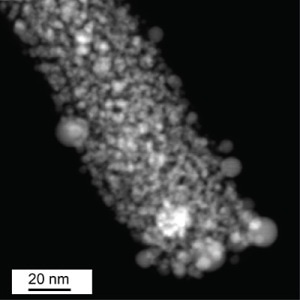Feb 8 2019
Compared to commercial platinum catalysts, a unique ruthenium-based catalyst created at the University of California, Santa Cruz has exhibited distinctly better performance in alkaline water electrolysis for hydrogen production. The catalyst is a nanostructured composite material made up of carbon nanowires with ruthenium atoms bonded to carbon and nitrogen to form active sites inside the carbon matrix.
 Electron microscopy of carbon nanowires co-doped with ruthenium and nitrogen shows ruthenium nanoparticles decorating the surface of the nanowires. Elemental mapping analysis shows individual ruthenium atoms within the carbon matrix. (Image credit: Lu et al., Nature Communications)
Electron microscopy of carbon nanowires co-doped with ruthenium and nitrogen shows ruthenium nanoparticles decorating the surface of the nanowires. Elemental mapping analysis shows individual ruthenium atoms within the carbon matrix. (Image credit: Lu et al., Nature Communications)
The electrochemical splitting of water to yield hydrogen is a vital step in the development of hydrogen as a clean, eco-friendly fuel. A lot of the effort to cut the cost and boost the efficiency of this process has concentrated on locating alternatives to costly platinum-based catalysts.
At UC Santa Cruz, scientists led by Shaowei Chen, professor of chemistry and biochemistry, have been exploring catalysts produced by integrating nitrogen and ruthenium into carbon-based nanocomposite materials. Their new findings, reported in the February 7th issue of Nature Communications, not only show the remarkable performance of their ruthenium-based catalyst but also deliver insights into the mechanisms involved, which may pave the way to additional improvements.
This is a clear demonstration that ruthenium can have remarkable activity in catalyzing the production of hydrogen from water. We also characterized the material on the atomic scale, which helped us understand the mechanisms, and we can use these results for the rational design and engineering of ruthenium-based catalysts.
Shaowei Chen, Professor of Chemistry and Biochemistry, UC Santa Cruz.
Electron microscopy and elemental mapping analysis of the material revealed ruthenium nanoparticles as well as separate ruthenium atoms within the carbon matrix. Remarkably, the scientists learned that the key sites of catalytic activity were single ruthenium atoms instead of ruthenium nanoparticles.
That was a breakthrough, because many studies have attributed the catalytic activity to ruthenium nanoparticles. We found that single atoms are the dominant active sites, although both nanoparticles and single atoms contribute to the activity.
Bingzhang Lu, Study First Author and Graduate Student, Chen’s Lab, UC Santa Cruz.
Lu partnered with co-author Yuan Ping, assistant professor of chemistry and biochemistry, to do theoretical calculations illustrating why ruthenium single atoms are more active catalytic centers than ruthenium nanoparticles.
“We did independent calculations from first principles to show how ruthenium forms bonds with carbon and nitrogen in this material and how this lowers the reaction barrier to give better catalytic activity,” Ping said.
A patent application has been filed by Chen for the experimental preparation of ruthenium-based catalysts. He observed that, besides potential applications for hydrogen manufacture as part of sustainable energy systems, alkaline water electrolysis is already extensively used in the chemical sector, as is an associated process called chlor-alkali electrolysis for which the ruthenium catalyst could also be employed. Therefore, a large market is already in place for inexpensive, more efficient catalysts.
The electrolysis of water to create hydrogen can be performed in either alkaline or acidic conditions, and each technique has benefits and drawbacks. Compared to alkaline media, platinum catalysts are a lot more effective in acidic media. The ruthenium-based catalysts perform nearly as well as platinum in acidic media, while outdoing platinum in alkaline media, Chen said.
Going forward, the scientists will aim to maximize the number of active sites in the material. They may also explore the usage of other metals in the same nanocomposite platform, he said.
Besides Chen, Lu, and Ping, the paper’s co-authors include Lin Guo, Feng Wu, Yi Peng, Jia En Lu, and Tyler Smart at UC Santa Cruz; Nan Wang at South China University of Technology; Zou Finfrock at Canadian Light Source; David Morris and Peng Zhang at Dalhousie University; and Ning Li and Peng Gao at Peking University. This study was aided by the National Science Foundation and UC Santa Cruz.